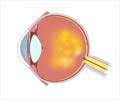It has emerged that bendy, stretchy and biocompatible arrays of light-emitting diodes (LEDs) and photodetectors would soon be used to light inside the body to activate drugs

Rogers' team has shown that by depositing coiled interconnecting metal wires onto the plastic, they can create a mesh-like array of LEDs and photodetectors that can withstand extreme mechanical deformation.
The mesh is then bonded to a pre-stretched sheet of rubber, which is encapsulated in a bio-compatible transparent piece of rubber.
The resulting circuit can be bent, twisted and stretched in any direction.
Tests have shown that the behaviour of the LEDs and photodetectors remains unchanged even after the circuit is repeatedly stretched by 75 percent.
Yet the flexibility has little to do with the devices themselves: t is mainly down to the interconnecting wires, whose coiled-up state accommodates a huge amount of expansion.
Advertisement
They think that versions of their rubber circuits could be used to administer light-activated drugs, and possibly also in the nascent field of phototherapy, which attempts to hasten the healing of wounds with lasers.
Advertisement
However, he has spotted a drawback: the use of interconnecting wires to take the mechanical strain keeps the device density low.
"The large spacing of the LEDs or photo-detectors will lead to a limited range of applications - no flexible displays, for example," Derby said.
The findings were reported in the Nature Materials.
Source-ANI












